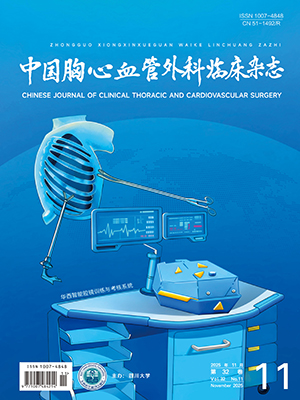| 1. |
潘文志, 方雁行, 李捷, 等. 经导管主动脉瓣置换术2023年度报告. 中国胸心血管外科临床杂志, 2024, 31(4): 498-503.Pan WZ, Fang YX, Li J, et al. Transcatheter aortic valve replacement (TAVR) annual report 2023. Chin J Clin Thorac Cardiovasc Surg, 2024, 31(4): 498-503.
|
| 2. |
Bansal A, Puri R, Yun J, et al. Management of complications after valvular interventions. EuroIntervention, 2025, 21(8): e390-e410.
|
| 3. |
Charlesworth M, Williams BG, Buch MH. Advances in transcatheter aortic valve implantation, part 2: perioperative care. BJA Educ, 2021, 21(7): 264-269.
|
| 4. |
Otto CM, Nishimura RA, Bonow RO, et al. 2020 ACC/AHA guideline for the management of patients with valvular heart disease: executive summary: a report of the American College of Cardiology/American Heart Association Joint Committee on Clinical Practice Guideline. Circulation, 2021, 143(5): e35-e71.
|
| 5. |
Vahanian A, Beyersdorf F, Praz F, et al. 2021 ESC/EACTS guidelines for the management of valvular heart disease. Eur Heart J, 2022, 43(7): 561-632.
|
| 6. |
中国医师协会心血管内科医师分会结构性心脏病学组, 亚太结构性心脏病俱乐部. 中国经导管主动脉瓣置换术临床路径专家共识(2024版). 中国循环杂志, 2024, 39(11): 1041-1057.Expert Consensus on Clinical Pathway for Transcatheter Aortic Valve Replacement in China Structural Cardiology Committee of Cardiovascular Physicians Branch, Chinese Medical Doctor Association, Asia Pacific Structural Heart Disease Club. 2024 expert consensus on clinical pathway for transcatheter aortic valve replacement in China. Chin Circ J, 2024, 39(11): 1041-1057.
|
| 7. |
张海涛, 曹芳芳. 心脏重症相关高血压管理专家共识的解读. 中国循环杂志, 2019, 34(S01): 96-97.Zhang HT, Cao FF. Interpretation of expert consensus on management of hypertension related to severe heart disease. Chin Circ J, 2019, 34(S01): 96-97.
|
| 8. |
张海波, 侯晓彤, 郭应强. 心尖途径经导管主动脉瓣置换术围术期管理规范专家建议. 中国胸心血管外科临床杂志, 2023, 30(7): 927-935.Zhang HB, Hou XT, Gu YQ. Expert recommendations for standardized perioperative management after transapical transcatheter aortic valve implantation. Chin J Clin Thorac Cardiovasc Surg, 2023, 30(7): 927-935.
|
| 9. |
Gasior T. 2024 update on cerebral embolic protection after transcatheter aortic valve replacement. J Clin Med, 2024, 13: 7256.
|
| 10. |
Grover FL, Vemulapalli S, Carroll JD, et al. 2016 Annual report of the Society of Thoracic Surgeons/American College of Cardiology transcatheter valve therapy registry. J Am Coll Cardiol, 2017, 69(10): 1215-1230.
|
| 11. |
Ten Berg J, Sibbing D, Rocca B, et al. Management of antithrombotic therapy in patients undergoing transcatheter aortic valve implantation: a consensus document of the ESC Working Group on Thrombosis and the European Association of Percutaneous Cardiovascular Interventions (EAPCI), in collaboration with the ESC Council on Valvular Heart Disease. Eur Heart J, 2021, 42(23): 2265-2269.
|
| 12. |
中华医学会心血管病学分会, 中华心血管病杂志编辑委员会. 经导管主动脉瓣植入术后抗血栓治疗中国专家共识. 中华心血管病杂志, 2022, 50(2): 117-131.Chinese Society of Cardiology, Chinese Medical Association, Editorial Board of Chinese Journal of Cardiology. Chinese expert consensus on antithrombotic therapy after transcatheter aortic valve implantation. Chin J Cardiol, 2022, 50(2): 117-131.
|
| 13. |
国家心血管病中心, 国家结构性心脏病介入质控中心, 中华医学会心血管病学分会, 等. 经导管主动脉瓣置换术临床实践指南. 中华医学杂志, 2023, 103(12): 886-900.National Center for Cardiovascular Diseases, National Center for Quality Control of Structural Heart Disease Intervention, Chinese Society of Cardiology, et al. Chinese guideline for the clinical application of transcatheter aortic valve replacement. Natl Med J China. 2023, 103(12): 886-900.
|
| 14. |
Biancari F, Pykäri J, Savontaus M, et al. Early and late pace-maker implantation after transcatheter and surgical aortic valve replacement. Catheter Cardiovasc Interv, 2021, 97(4): E560-E568.
|
| 15. |
Mohammadi NSH, Tavakoli K, Taebi M, et al. Comparative prognostic value of risk factors for predicting pacemaker implantation after transcatheter aortic valve replacement: a systematic review and network meta-analysis. Am J Cardiol, 2025, S0002-9149(25): 00296-6.
|
| 16. |
Yu Q, Fu Q, Xia Y, et al. Predictors, clinical impact, and management strategies for conduction abnormalities after transcatheter aortic valve replacement: an updated review. Front Cardiovasc Med, 2024, 11: 1370244.
|
| 17. |
Glikson M, Nielsen JC, Kronborg MB, et al. 2021 ESC guidelines on cardiac pacing and cardiac resynchronization therapy. Eur Heart J, 2021, 42(35): 3427-3520.
|
| 18. |
Matthew W, Sherwood, Katelyn, et al. Incidence, temporal trends, and associated outcomes of vascular and bleeding complications in patients undergoing transfemoral transcatheter aortic valve replacement: insights from the Society of Thoracic Surgeons/American College of Cardiology Transcatheter Valve Therapies Registry. Circ Cardiovasc Interv, 2020, 13(1): e008227.
|
| 19. |
范嘉祺, 刘先宝, 艾丽菲热·艾合买提, 等. 经导管主动脉瓣置换术围手术期冠状动脉闭塞的评估和处理流程. 中国介入心脏病学杂志, 2023, 31(6): 461-466.Fan JQ, Liu XB, Ailifeire·aihemaiti, et al. Perioperative evaluation and management of coronary obstruction in transcatheter aortic valve replacement. Chin J Interv Cardiol, 2023, 31(6): 461-466.
|
| 20. |
Wunderlich NC, Honold J, Swaans MJ, et al. How to image and manage prosthesis-related complications after transcatheter aortic valve replacement. Curr Cardiol Rep, 2021, 23(8): 94.
|
| 21. |
Zou Q, Wei Z, Sun S. Complications in transcatheter aortic valve replacement: a comprehensive analysis and management strategies. Curr Probl Cardiol, 2024, 49(5): 102478.
|
| 22. |
Toggweiler S, Leipsic J, Binder RK, et al. Management of vascular access in transcatheter aortic valve replacement: part 2: vascular complications. JACC Cardiovasc Interv, 2013, 6(8): 767-776.
|
| 23. |
Habertheuer A, Gleason TG, Kilic A, et al. Impact of perioperative stroke on midterm outcomes after transcatheter aortic valve replacement. Ann Thorac Surg, 2020, 110: 1294-1301.
|
| 24. |
Huded CP, Tuzcu EM, Krishnaswamy A, et al. Association between transcatheter aortic valve replacement and early postprocedural stroke. JAMA, 2019, 321: 2306-2315.
|
| 25. |
Avvedimento M, Cepas-Guillén P, Garcia CB, et al. Incidence, predictors, and prognostic impact of neurologic events after TAVR according to VARC-3 criteria. JACC Cardiovasc Interv, 2024, 17(15): 1795-1807.
|




